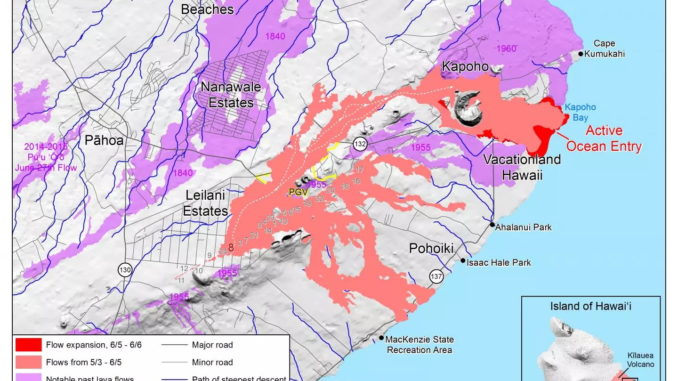
BY NINA GODLEWSKI
June 8, 2018
Hawaii’s Kilauea volcano erupted more than a month ago and liquid rock has been spewing from it and its fissures ever since. Lava flows have destroyed an entire neighborhood, traveling so far that it has reached the ocean and the mayor’s house on the island.
A message from the Civil Defense Agency Thursday said fissure 8 was still very active and flowing. The lava was flowing into Kapoho Bay and the message said the bay was filled with lava Thursday.
The delta of lava that the flows formed was 1.5 miles wide as of Thursday evening and was expanding from the isolated Vacationland area in the direction of Kapoho Beach Lots.
Since the volcano first erupted, more than 113.5 million cubic meters of lava have spread across the island, with some making it into the ocean. It’s enough lava to cover the island of Manhattan in 6.5 feet deep of lava, according to the United States Geological Survey.
When hot lava enters the cool Pacific Ocean it creates a by-product called laze. Policies were in effect prompted by the increase in laze that was forming as lava flowed into the ocean from the constant volcanic activity. That laze is a hazy plume of hydrochloric acid, glass and steam that is released into the air following the combination of lava and the ocean water. Laze can cause eye and skin irritation in addition to lung damage, and plumes can move easily with the wind.
Thursday and Friday’s active flows prompted officials to issue evacuation orders for Leilani Estates, Pomaikai Street and other neighborhoods in the area. Residents with credentials were allowed in some areas to inspect their property.
Early Friday morning in Hawaii there was an explosion near the summit of Kilauea with a plume likely reaching less than 10,000 feet in the air, the USGS tweeted.
Gas emissions from the lava and volcano were still high and a danger for those in the area and downwind from the lava flows. The sulfur dioxide coming from the volcano can also cause respiratory issues, especially for those who already have trouble breathing like people with asthma. The gases released from the eruption also have the potential to cause acid rain to fall on the island.
A map from the USGS, last updated on Wednesday, shows where the lava had recently expanded. As maps are updated, they will be posted to the USGS website.
Source:http://www.newsweek.com/hawaii-volcano-kilauea-explosion-map-flow-update-lava-967124
Visits: 74




Be the first to comment